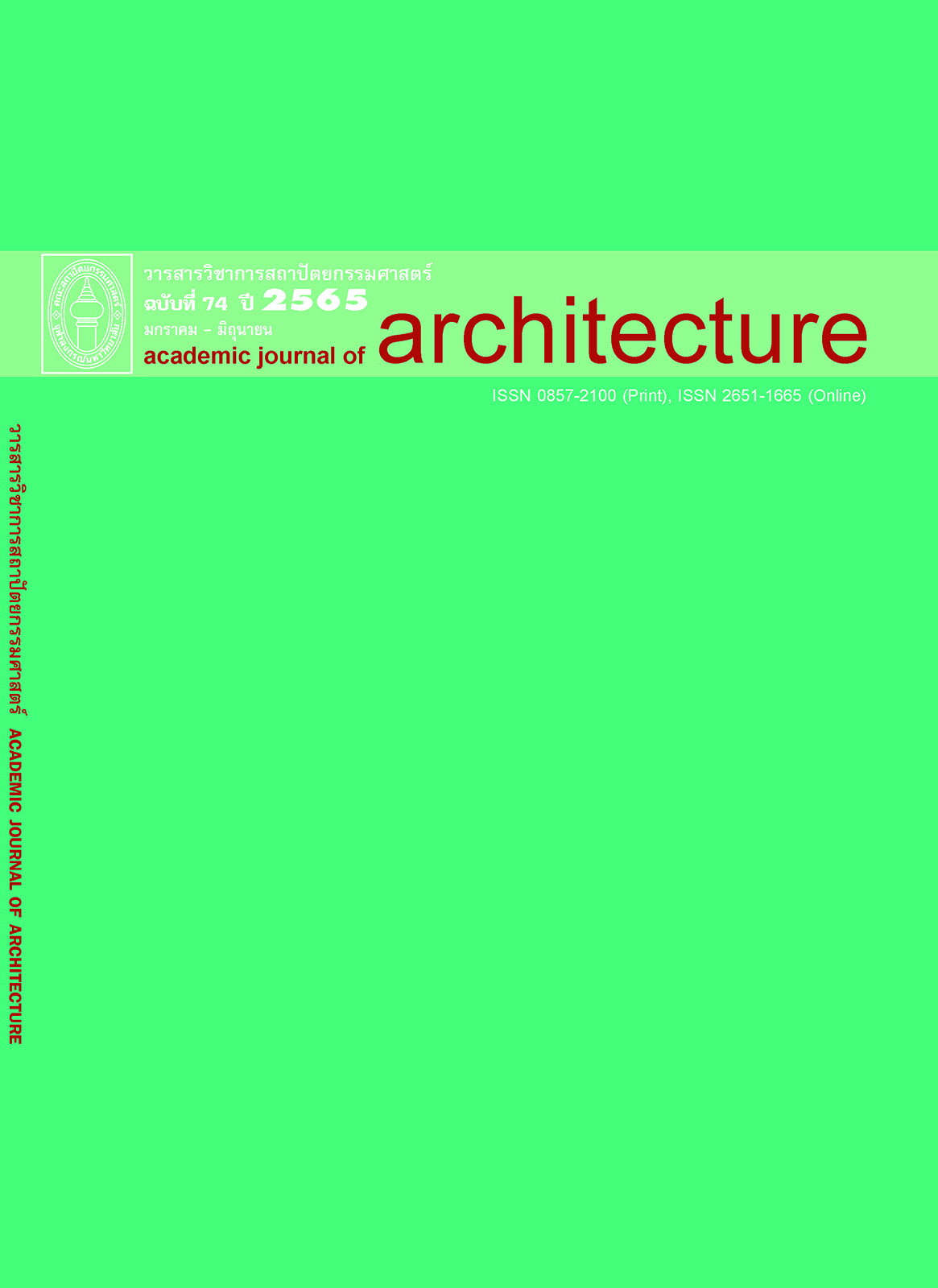The Development of Chinese Cemeteries in Indochinese Peninsula and the Malay Archipelago
Main Article Content
Abstract
Chinese cemeteries, defined as a cultural heritage and a cultural landscape, represent human settlement and patrimony of traditions and beliefs of the immigrant Chinese in Southeast Asia. This article presents the studies of overseas Chinese cemeteries from the past to the present in physical forms and related beliefs, their developments, including an analysis of current cemeteries and their roles in the future. Results from collection and analysis, the cemeteries were classified into three periods according to their characteristics and other social aspects. Elements affecting the physical form of both historic and modern cemeteries and their treatments are usages, values or beliefs, and socio-economic factors. The results also indicate the future trends of cemeteries are as follows: first, retain the original role of preserving the human remains; second, adjust physical changes to suit the socio-economic conditions; third, support new functions as a park, a learning resources, and cultural heritage; otherwise, they are at risk of being demolished.
Article Details
References
กระทรวงวัฒนธรรม สำนักงานคณะกรรมการวัฒนธรรมแห่งชาติ และ มหาวิทยาลัยศิลปากร คณะสถาปัตยกรรมศาสตร์. (2549). แนวทางการจัดการภูมิทัศน์วัฒนธรรม. กรุงเทพฯ: อมรินทร์.
เกรียงไกร บุญธกานนท์. (2531). สุสาน (ฮวงซุ้ย) สำคัญอย่างไร. สืบค้นเมื่อ 1 มีนาคม 2565, จาก http://www.fengshuitown.com/fengshui/fengshui-tip-book51-graveyard.htm
นที ศรีตานี. (2534). ที่ระลึกงานสมโภช เจ้าแม่ลิ้มกอเหนี่ยว: ศาลเจ้าเล่งจูเกียง ปัตตานี. แปลโดย เคี่ยม สังสิทธิเสถียร. ยะลา: ยะลาการพิมพ์.
นภัสวรรณ สุภาทิตย์, บุญรอด บุญเกิด และ บุญเลิศ ยองเพ็ชร. (2559). พิธีกรรมศพของคนไทยเชื้อสายจีน ในจังหวัดชลบุรี. วารสารการเมือง การบริหาร และกฎหมาย, 8(1), 323 - 40. สืบค้นจากhttp://www.polsci-law.buu.ac.th/journal/document/8-1/10.pdf
ประสิทธิ์ เงินชัย. (2557). การดำรงอยู่และบทบาทของวัฒนธรรมจีนในภาคตะวันออก. วารสารการเมือง การบริหาร และกฎหมาย, 6(2), 63-75. สืบค้นจาก http://www.polsci-law.buu.ac.th/journal/document/6-2/2.pdf
ปรารถนา โกเมน. (2533). สมาคมชาวจีนในกรุงเทพฯ ค.ศ. 2440-2488. (วิทยานิพนธ์ปริญญามหาบัณฑิต, จุฬาลงกรณ์มหาวิทยาลัย).
ปริวัฒน์ จันทร. (2548). การสำรวจทางทะเลของเจิ้งเหอ; 30 ปี ความสัมพันธ์ไทย-จีน 600 ปี ซำปอกง/เจิ้งเหอ กับ อยุธยาและอุษาคเนย์, หอประชุมกองทัพเรือ. กรุงเทพฯ: มูลนิธิโตโยต้าประเทศไทย บริษัท โตโยต้า มอเตอร์ ประเทศไทย จำกัด-มูลนิธิโครงการตำราสังคมศาสตร์และมนุษยศาสตร์.
เปรมา สัตยาวุฒิพงศ์. (2546). แรงงานรับจ้างชาวจีนในกรุงเทพฯ ตั้งแต่ พ.ศ. 2425-2492. (วิทยานิพนธ์ปริญญามหาบัณฑิต, จุฬาลงกรณ์มหาวิทยาลัย).
พรพรรณ จันทโรนานนท์. (2550). ชาวจีนในไทยมาจากไหน เปิดประวัติการอพยพยุคแรกเริ่ม ถึงการผสมกลมกลืนทางวัฒนธรรม. สืบค้นเมื่อ 8 ธันวาคม 2564, จาก https://www.silpa-mag.com/songwad-century/article_26173
ไพรถ เลิศพิริยกมล. (2547). "ฮวงจุ้ย" ความเชื่อถือและปฏิบัติที่สืบต่ออย่างน่าพิศวง. สืบค้นเมื่อ 7 ธันวาคม 2564, จาก https://thaifolk.com/doc/literate/hungjui/hungjui1.htm
วลัยลักษณ์ ทรงศิริ. (2562, 23 พฤษภาคม). เมืองจันทบูรเก่า. สืบค้นเมื่อ 4 กุมภาพันธ์ 2565, จาก https://suanleklek.wordpress.com/2019/05/23/old-chantaboon/
ศศิภา พูลบูลย์. (2556). ระบบวิเคราะห์แบบร่างสถาปัตยกรรมภายในตามหลักฮวงจุ้ย. (วิทยานิพนธ์ปริญญามหาบัณฑิต, มหาวิทยาลัยศิลปากร).
ศุภกาญจน์ สุจริต. (2559). คติความเชื่อและรูปแบบเทพเจ้า “ปุนเถ้ากง” ของชาวจีนโพ้นทะเลในสมัยรัตนโกสินทร์ กรณีศึกษาในเขตกรุงเทพมหานคร.(วิทยานิพนธ์ปริญญามหาบัณฑิต, มหาวิทยาลัยศิลปากร).
Akpedonu, Erik. (2016, October 15). The Manila Chinese cemetery: A repository of Tsinoy culture and identity. Archipel, 92, 111-53. Retrieved from https://doi.org/10.4000/archipel.288
Cheng Hoon Teng Temple. [n.d.]. History of the temple. Retrieved December 6, 2021, from http://chenghoontengtemple.com/en/history/history
Dian, Zhang. (2004). Land for the dead: Locating urban cemeteries, case study Guilin. (Master’s thesis, ITC Enschede).
Groot, Jan Jakob Maria. (1897). The religious system of China: Its ancient forms, evolution, history and present aspect, manners,customs and social institutions connected therewith Vol. 3: Dutch colonial government. Retrieved from https://archive.org/details/religioussystemo03groo/page/n7/mode/2up
Han, Ke-Tsung. (2001, September 1). Traditional Chinese site selection-Feng Shui: An evolutionary/ecological perspective. Journal of Cultural Geography, 19, 75-96. Retrieved from https://doi.org/10.1080/08873630109478298
Loo, Yat Ming. (2013). Architecture and urban form in Kuala Lumpur. Farnham: Ashgate.
marchouliston. (2017). Bukit Cina Chinese Cemetery [Photograph]. Retrieved November 30, 2017, from http://marchouliston.com/Malaysia_2017/BukitCina.html
Poston, Dudley, & Wong, Juyin. (2016, July 1). The Chinese diaspora: The current distribution of the overseas Chinese population. Chinese Journal of Sociology, 2, 348-73. Retrieved from https://doi.org/10.1177/2057150X16655077
Raksaperdana, Ikrar, & Kurniawan, Kemas. (2021, May 1). Souw Beng Kong’s tomb: Transformation of a green Chinese cemetery area to a present dense area. IOP Conference Series: Earth and Environmental Science, 764, 012013. Retrieved from https://doi.org/10.1088/1755-1315/764/1/012013
Salmon, Claudine. (2016, October 15). From cemeteries to luxurious memorial parks: With special reference to Malaysia and Indonesia. Archipel, 92, 177-212. Retrieved from https://doi.org/10.4000/archipel.320
Singapore Society Heritage. (2017). Bukit brown self-guided wayfinder trail. Singapore: Singapore Heritage Society.
United Nations Educational, Scientific and Cultural Organization. (2003). What Is intangible cultural heritage? Paris: UNESCO. Retrieved from https://ich.unesco.org/doc/src/01851-EN.pdf
Wong Tze Ken, Danny. (2016). Early Chinese presence in Malaysia as reflected by three cemeteries (17th-19th C.). Archipel, 92, 9-21. Retrieved from https://doi.org/10.4000/archipel.280
Wu, F., & Y. Zhao, Y. (1996). Thinking on cemetery culture. Journal of Jianghan University, 13(5), 93-96.


